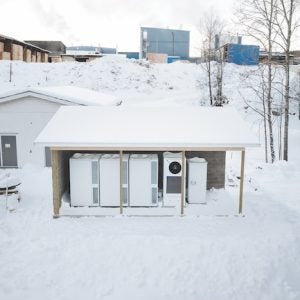The 30 MW array, operated by Statoil in partnership with Masdar, is located 25 km offshore at Peterhead in Aberdeenshire, Scotland. Despite one hurricane, one winter storm and wave heights of up to 8.2 metres, Hywind achieved an average capacity factor of approximately 65% during the period November 2017 to January 2018. This means that the wind farm was producing 65% of its maximum theoretical output in MW terms. A capacity factor of 100 % would mean that all the turbines had generated at maximum output every second of the day.
These figures compare well to the typical capacity factor of 45-60% for a bottom fixed offshore wind farm during the winter, when the wind is at its strongest.
“We have tested the Hywind technology in harsh weather conditions for many years and we know it works. But putting the world’s first floating wind farm into production comes with some excitement. Therefore, it is very encouraging to see how well the turbines have performed so far. Hywind Scotland’s high availability has ensured that the volume of electricity generated is substantially higher than expected. In addition, it has delivered without any health and safety incidents,” commented Beate Myking, senior vice president of offshore wind operations at Statoil.
Hywind Scotland’s first encounter with harsh weather conditions was the hurricane Ophelia in October when wind speed of 125 km/h (80 mph) were recorded. These wind speeds were exceeded during Storm Caroline in early December when gusts in excess of 160 km/h (100 mph) and waves in excess of 8.2 metres were recorded.
Whilst the wind turbines shut down for safety reasons during the worst of these winds, they automatically resumed operation soon afterwards. A pitch motion controller is integrated with the Hywind turbine’s control system and will adjust the angle of the turbine blades during heavy winds, which mitigates excessive motions of the structure.
More Hywind?
“Knowing that up to 80% of the offshore wind resources globally are in deep waters (60+ metres) where traditional bottom fixed installations are not suitable, we see great potential for floating offshore wind: in Asia, on the west coast of North America and in Europe. We are actively looking for new opportunities for the Hywind technology,” stated Irene Rummelhoff, executive vice president for New Energy Solutions at Statoil.
Statoil and Masdar have an ambitious plan to reduce the costs of energy from the Hywind floating wind farm to 40-60 €/MWh by 2030, making it cost competitive with other renewable energy sources. “This is an ambitious, but realistic target. Optimised design, together with larger and more efficient turbines, technology development and larger wind parks will drive down costs, improve infrastructure and logistics,” Rummelhoff says.






